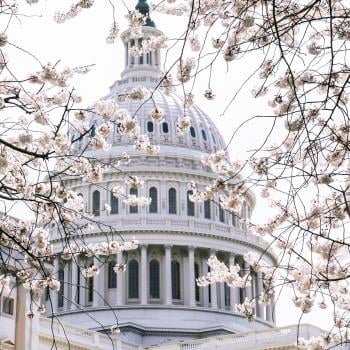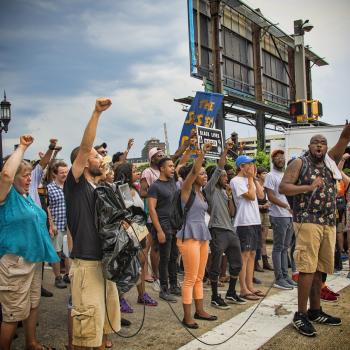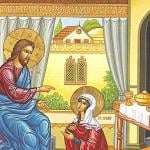Although it’s half a week late, I preached a short homily this last weekend in Seattle. Soup & Bread Gathering and St. Andrew’s Episcopal Church, thank you for allowing me to step into your pulpits. As per the rest of you, enjoy!

—
Today marks the first Sunday of Lent, the first Sunday in a season of reflection and remembering – in a season of going deeper into ourselves, in a season of “bright sadness,” as one theologian puts it. It’s a time when many of us are giving something up for a period of 40 days, maybe, perhaps so we might forget about ourselves for just a little bit and draw near to God, draw closer to the One who was tempted himself yet didn’t give in to said temptations.
Just a couple of days ago, I read an article that according to Twitter (a very reliable news source), the #1 most given up thing for Lent this year is PLASTIC – the environmentalists among us rejoice – and this was closely followed by chocolate, coffee, alcohol and social media, just to name a few.
Of course, perhaps like some of you, I didn’t grow up in a liturgical tradition. I didn’t grow up in a church that followed the lectionary calendar – instead, we celebrated Christmas and Easter and the annual spring picnic held at Bush Park between the Episcopalians and the Baptists. Those “Amen!” Baptist preachers preached according to topics and come once a month, the service went extra long, due in part to a warbled, choral version of “The Lord’s Prayer” and tiny communion cups of grape juice and Matzo crackers being passed up and down the pew aisles.
So it wasn’t until I got to college – to Pacific Lutheran University, just down the road in Tacoma – that I became familiar with the liturgical tradition, with giving something up so that I might draw closer to God.
As such, my sophomore year of college, I found it fitting to give up elevators.
Obviously.
I lived on the fourth floor of Tingelstad Hall, so it made sense. It would be a lot to traipse up and down those four flights of stairs numerous times a day; it would be a lot to not be able to take the elevator when my weary legs were tired. It would be a lot to carry my backpack, full of notebooks and pens and textbooks and granola bars and Nalgene bottles up and down those stairs, because OH. Woe was me! Woe were my legs!
But if I’m honest with you and with myself, giving up elevators for Lent didn’t have a whole lot to do with drawing closer to God, drawing closer to this season of bright sadness, drawing closer to a chance to respond to what God actually might be inviting me into this season.
Instead, Lent mostly had to do with lamenting my sore and tired legs and wondering if all those extra steps might help me lose the previous year’s Freshman 15.
But in a way, I also don’t need to be too hard on myself, because as a 19 year old, that season of Lent still brought me into a deeper knowing of who I was at the end of the day …even if it was a knowing of realizing that I really, really liked taking the elevator.
After all, Lent can help us go deeper into ourselves. As one friend reflected this last week, Lent helps us remember whose we are and who we are – for Lent is, in essence, a question of identity. So when we remember that we are but dust, and to dust we shall return, we also ultimately, eventually come to remember that we are resurrection people.
And this bit of identity-remembering is also at the heart of today’s gospel reading.
In Luke 4, Jesus is led into the wilderness, a wilderness perhaps not too far from some of our journeys right now, when we’re led into a place that feels dry and arid, a place in which we’re stripped down, hoping, begging, pleading for the great feast of Easter. Perhaps this is your story now.
But of the passage, this much we know: Jesus entered the desert full of the Holy Spirit, the God parts of him fully alive, even in the midst of absolute hunger. For 40 days, the devil tested him, three times of which we (as readers) are made privy to – twice in the wilderness and once on the pinnacle of a temple in Jerusalem. Three times he uses “if” statements – if you are the Son of God… if you, then will worship me… if (again) you are the Son of God – then prove it to me now.
Of course, were my four-year old son were here, he’d have no problem answering the question – God bless that Lutheran school education.
“Mama,” he said to me the other day. “Do you know who I hate?”
“Well, hate is a strong word, buddy.”
“S, s, s!”
“Starts with an s?”
“Satan! And bad guys!”
So, to Theo, we say thank you, but for the rest of us, the IF is always present in our lives.
And the IF that was present in Jesus’ life in those 40 days was no exception, because maybe the “if” wasn’t so much a temptation, as one theologian writes, but a testing …a testing to see WHO he was at the end of the day – a testing that perhaps just like us, begged an answer to the question, “Who are you at the end of the day? Who are you at the end of it all? Who are you in this season of deep reflection, when bright sadness seems to light our path more than the cheery, exuberant wonder of Advent, of Epiphany and of the Easter season?
As some of you know, my book just released. And yes, yay! It’s a season of celebration …and of exhaustion too. But as early readers can attest, my book is also an invitation that asks who we are, especially when it comes to issues of justice, race and privilege. Yes, my book is a spiritual memoir about my journey toward these issues, but if I can be so bold, it’s also an invitation to every single one of us to see who we are at the end of the day.
Who are we going to be, as followers of Christ, when although every single one of us has been created in the image of God, not every life has been given equal value, worth and dignity in the eyes of society? Who are we going to be, as a Church, when invitations to extend compassion and show justice to the least of these, show up on our doorstep? Who are we going to be, when following in the Way of Love, doesn’t just mean conversion and evangelism, but it means doing something about broken systems that benefit some but not all?
“It’s wonderful what you do, Cara,” one friend said to me, referring to conversations of race and justice. “And it’s wonderful what your church does, but my church just isn’t that kind of church. We’re not those kind of Christians.”
But we are those kinds of Christians and we are that kind of church, for this is at the core of our identity. This is at the core of the One we follow, of the one we call Lord, of the one for whom we plead mercy.
Maybe I’m getting ahead of myself here, but just four verses later, Jesus reminds the people of who he is – just as he is no longer in the desert, Luke no longer points to what he’s NOT going to do, to those “if’s” that the devil tried his hardest to test him with. Instead, we are brought into the positive, reminded that Jesus will bring “good news to the poor …release to the captives … recovery of sight to the blind … and freedom for the oppressed,” for THIS is who Jesus is and was at his core.
So in this season of Lent, as we are brought into bright sadness and deep reflection of who we are at our core, we are also brought into a time of remembering WHOSE we are …and this God, of WHOSE we claim, is a God of justice and mercy, a God whose church IS that kind of Church, a God whose people ARE those kind of people.
Might we remember this as we step into this season, as we beg that justice and mercy and wholeness be for every single one of us, and as we take steps of action, following in the Way of Love.
Amen.
—
So. You ready to be those kind of Christians and this kind of Church? Me too.











